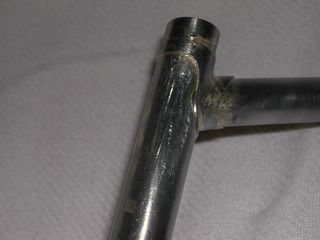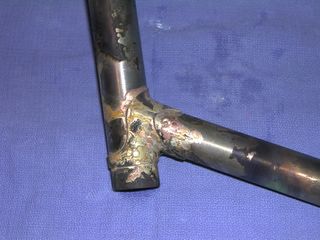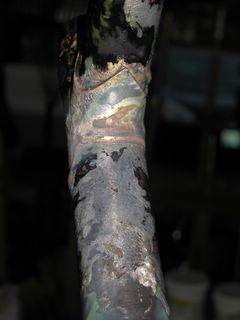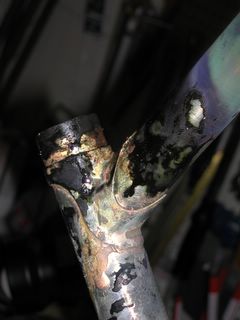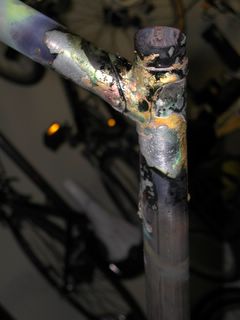Its interesting, there have been a number of nice notes regarding the site from want-to-be framebuilders who haven't taken the first step yet. The old saw is that an expert is someone who knows one more thing than you do. Some of the questions received may prove the point. But, perhaps my lack of expertise is what make me an approachable source? Anyhow, I'm happy to share my knowledge and opinions and will try to distinguish between the two in my replies. Everyone is free to ask questions - but should understand that I don't have all the answers. Fair enough?
I've been asked about jigs (this post may be of little or no interest to the established builder) and it seems likely that every soon-to-be framebuilder thinks about this a lot. I certainly did. To begin with, one either works on the floor, a welding table, or with some form of jig. Let's face it, welding (brazing) on the floor is crude and rude. For many, a welding table is just one more thing to buy and thus an impediment to getting started. So the jig is already sounding attractive. Then there's the question of alignment. Without a jig, how will anything be in alignment? One may even believe that holding the frame pieces firmly in their aligned positions until cooled will result in minimal cold-setting. This makes a jig sounds pretty good.
Of course, not all brazing (or welding) can be done in all jigs. And in reality, the authorities I've consulted (don't expect me to footnote a silly blog) are quite clear that primary (my term for pre-cold setting) alignment is achieved by: 1) careful fitting of tubes, lugs, and bits so they are aligned in their pre-brazed state; 2) fixing (pinning or tacking) the joints firmly, but with minimal heat, in this alignment; 3) carefully heating the tubes, maintaining symmetry in the application of heat, and careful cooling of the frame. It seems that the most key aspect of this is the heating process, which by the way is helped by applying heat for the minimal time necessary. None of this speaks to the use of jigs. So, the intuitive approach of new-to-be builders is probably a bit off the mark regarding jigs.
That said, something is required to help make sure the parts of each joint are properly aligned. As Suzy Jackson has so ably demonstrated (as well as have many before her), the solution can be as simple as a straight, stiff, piece of aluminum of sufficient length. I especially like her approach to the rear triangle. If you haven't visited her site, you should. Considering the startup costs, unless one already has a basic metal-working capable workshop, jigs are probably an unnecessary initial investment. They have the potential to help make the process faster, and if you're building for a living this could be critical. For myself, a lug mandrel seems more important - so that one can hold the lugs without damage while working them to a proper fit around their tubes.
My journey is beginning with the use of a beam made of 80/20 extrusion.
But, let's further explore this jig thing a little further. I've had some discussions with Doug Fattic about his English jig, and feel like maybe this has opened my eyes a bit to the options for and goals of a jig.
First let me say this is not the place to debate what's a fixture and what's a jig. The term jig is being used here with a broad definition. For my purposes, the beam I use is a jig. It helps hold pieces in their proper relationship to each other for assembly. But is that all a jig can or should do?
What about facilitating properly spaced/angled/centered miters? How about laying out a design, and establishing the relationships between different pieces? Certainly Anvil and Bringheli and others offer jigs to help cut tubes - some of which are quite specialized. But generally, I think most soon-to-be builders are thinking about building jigs. So, let's focus on them.
Most of the building jigs I'm aware of, both commercial and homemade, work based on a vertical alignment of the frame. They may allow all sorts of motion, twisting, tilting and swiveling in order to make better access to the various joints, but they start with an essentially vertical orientation. The jigs also allow a variety of motions for the tubes and fittings of the frame- the basic geometry of a bike frame may seem simple, but the diamond frame has few instances where a single variable is independent and any jig design has to account for this. How this is done may be more important to you as a builder than the various movements and access holes that are commonly advertised.
Take for example the matter of BB (bottom bracket) drop (I don't use height because it is dependent upon the wheels and tires installed). In the case of a bike with a level TT (top tube), lowering the BB has the effect of making the HT (head tube) shorter and brings the TT closer to the ground. If a jig clamps the TT (some do and some don't), then these clamps must move with the ST (seat tube) BB combination. Moreover, if the TT clamps to the jig, then there must be a mechanism to establish and lock its height above the BB, as well as a mechanism to adjust and lock its angle (if compact frames are desired).
One might ask, well why have the complication of a clamped TT? There are two reasons: 1) unless lugs are being used, the TT can be easily bumped ajar until its been tacked; 2) clamping the TT means that there is a mechanism to sight against the HT to determine its proper length. So, now the question is: haven't you determined the HT length in the design process when you did your drawing. Indeed this is a reasonable way of doing things and to my mind a necessary method when work is based on a beam. But, with the right configuration of jig, its possible to create the design directly on the jig.
This is where Doug Fattic's approach comes in. His jig allows for clamping all of the tubes of the main triangle. It maintains the necessary inter-relationships between the parts while allowing for the requisite modification of tube lengths, wheelbase, BB drop, etc. This jig is used lying down on an alignment table, and has inscribed measures of length and angle throughout. So, Doug can position his seat, handlebars and cranks on the jig - and adjust their relative positioning to achieve the fit he's looking for. Then he can review the various angles, heights and tube lengths to ensure that he obtains the handling he seeks. Finally, he can read off the angles and lengths he needs to cut his tubes appropriately. In the end, he hasn't had to use a piece of paper, but has designed the whole frame on the jig. Pretty neat. I would suggest that an added advantage is that the tubes are held in place by gravity. Yes he clamps them in, but setting things up, he sets the tubes on their v-blocks and they stay in place. Little or no possibility of dropping a tube on the floor. Try that with a vertical jig.
Is Doug's jig the ultimate tool? Probably not. It provides no support for argon purging, so it isn't a particularly good place for tig welding. It is not intended for welding or brazing up joints. Rather the joints are tacked or pinned, and the frame is lifted out of the jig, set on a bike stand or in a vice, and brazed from there. Is this the fastest production method? Probably not, as Doug will attest. But to do his sort of one-of-a -kind building, his jig not only helps him achieve good primary alignment, but helps his whole design/specification process. And, he feels that this nets out with a faster process for him.
Note: I don't know of anywhere that you can buy an English style jig. Doug is looking at developing and publishing a plan based on 80/20 extrusions - which may someday be available for folks to build their own.
Going back to the vertical jigs, they're not a bad thing. If you prefer to plan on paper or a computer (which gives you the option of saving the design), a vertical jig works fine. Some do provide argon purge for TIG, and some have the necessary standoff to braze/weld on the jig.
Other considerations: 1) Do you build a fork first and design/jig around that?; 2) Does the jig design work from a dummy headset requiring you to cut your headtube to length, or is the HT set on cones which can be distant form the location of the headset cups? Some builders prefer to trim the headtube as one of their last steps - this allows some flexibility for unexpected fork dimensions, plus the excess tube provides a place to feed the rod in while brazing the head lugs. 3) If measures are built into the jig, are they accurate? Is there a way to reset them to allow for wear etc.?; 4) What dimensions (wheel size, rider size, tube diameter) of frame do you anticipate building over time, and are these covered by the jig?
How heavy is the jig? Does it come on a stand? Is it balanced/counterbalanced so when you whirl it around - it will stay where you want it? How easily is it locked into a precise position? How long will the locks last? Is there a risk that the locking mechanisms may distort the jig?
There are lots of things to think about before selecting a jig. I probably haven't listed most of them. The key thing is that the jig will define how you work. To the degree that you've done some building and have some opinions regarding how you want to work, that will be an advantage in deciding if and what jig to buy. In the meantime, a stout beam (one that can be clamped tightly in a vice as it cantilevers out, holding your frame in position to braze) is probably the best way to start. IMHO
Cheers






























